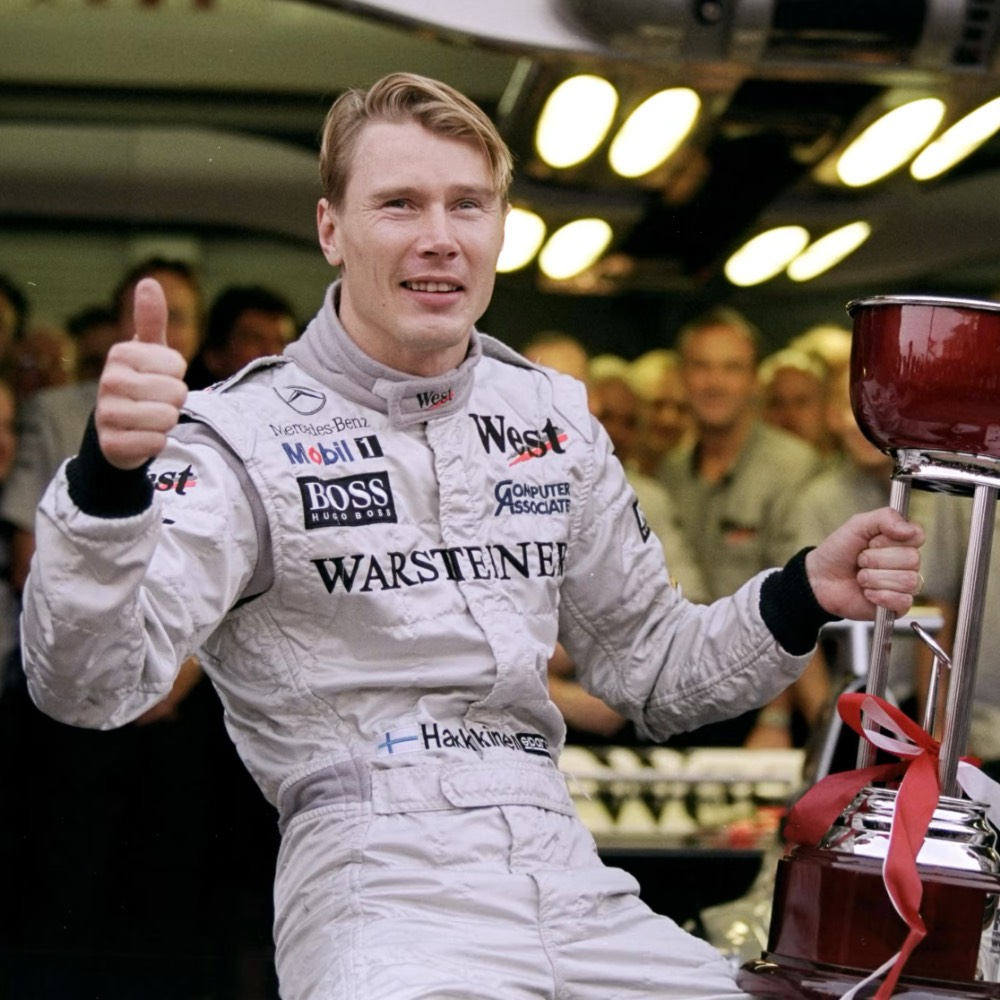
Mika Häkkinen
World Championships
1998-1999
Career Statistics
Biography
Mika Pauli Häkkinen (born 28 September 1968) is a Finnish racing driver who competed in Formula One from 1991 to 2001, winning back-to-back World Drivers' Championships in 1998 and 1999 with McLaren-Mercedes in one of the sport's greatest rivalries with Michael Schumacher, establishing himself as the "Flying Finn" whose ice-cool demeanor, devastating speed, and precision driving made him one of the 1990s' dominant forces and Finland's second World Champion. Born and raised in Vantaa, Finland, Häkkinen began karting at age five and quickly demonstrated exceptional natural talent, winning several regional and national championships throughout his youth. Under the mentorship of 1982 World Champion and fellow Finn Keke Rosberg, who recognized the young driver's potential, Häkkinen progressed through the junior categories with impressive results.
He claimed the Nordic Formula Ford Championship before moving to Britain, where he won the prestigious 1990 British Formula Three Championship with West Surrey Racing, defeating future F1 rivals including Rubens Barrichello. His F3 success attracted the attention of McLaren team principal Ron Dennis, who signed Häkkinen as a test driver for 1992 and took a paternal interest in his career development, recognizing qualities that reminded him of Ayrton Senna. When McLaren's 1993 partnership with Michael Andretti failed to deliver results, Dennis promoted Häkkinen to replace the struggling American for the final three races of the season, partnering the legendary Senna. In a moment that announced his arrival, Häkkinen sensationally out-qualified Senna on his debut at the Portuguese Grand Prix—a remarkable achievement that demonstrated his raw speed and earned Senna's respect.
Following Senna's tragic death at Imola in 1994, Häkkinen continued with McLaren, enduring frustrating seasons in uncompetitive machinery throughout 1995-1996 as Mercedes-Benz engines proved unreliable and McLaren's designs failed to deliver consistent performance. During this difficult period, Häkkinen suffered a life-threatening accident during qualifying for the 1995 Australian Grand Prix in Adelaide when his McLaren's tire deflated at high speed, sending him into the barriers at approximately 120 mph. The impact caused a severe basilar skull fracture, and Häkkinen required an emergency tracheotomy performed trackside by Professor Sid Watkins, Formula One's medical chief, that saved his life.
The injury sidelined Häkkinen for the final race of 1995, and his recovery required months of rehabilitation, but remarkably he returned fully fit for 1996 with no lasting effects. The 1997 season marked Häkkinen's breakthrough when Adrian Newey's improved McLaren MP4/12 and the new Mercedes V10 engine finally gave him competitive machinery. He scored his maiden Formula One victory at the European Grand Prix at Jerez, Spain, a deeply emotional moment after 96 races and six years of waiting, and added a second win in Canada, establishing himself as a championship contender for 1998. The 1998 and 1999 seasons witnessed one of Formula One's greatest rivalries as Häkkinen's silver McLaren-Mercedes and Michael Schumacher's red Ferrari became the dominant forces, with the World Championship decided in an intense battle between two of the era's fastest drivers.
In 1998, Häkkinen and Schumacher each won eight races, with their championship fight going down to the final race at Suzuka, Japan. Häkkinen took a masterful pole position and led home a McLaren 1-2 finish to claim his first World Drivers' Championship, becoming Finland's second World Champion after Keke Rosberg. The following year brought another fierce battle with Schumacher, complicated by Schumacher's broken leg sustained at the British Grand Prix that sidelined him for six races. Häkkinen capitalized on his rival's absence and, despite strong challenges from Ferrari's Eddie Irvine—who led the championship late in the season—successfully defended his title at the final race in Japan, winning by just two points to secure back-to-back championships.
Häkkinen's 1999 campaign featured five victories and demonstrated his ability to perform under intense pressure, delivering when it mattered most. The 2000 season saw Häkkinen win four races but finish runner-up to Schumacher as Ferrari's improved F1-2000 proved slightly superior to McLaren's MP4/15, ending Häkkinen's championship reign at two titles. His 2001 season began competitively with wins in Britain and the United States, but reliability issues and Ferrari's continued improvement saw him finish fifth in the championship. At season's end, Häkkinen announced he would take a sabbatical year in 2002 to spend time with his family and consider his future, but the sabbatical became permanent retirement as he never returned to Formula One, despite speculation linking him to various teams.
Häkkinen retired at age 33 with 20 Grand Prix victories from 165 races, 26 pole positions, 25 fastest laps, and 51 podium finishes—statistics that place him among Finland's greatest sporting heroes alongside Kimi Räikkönen. After Formula One, Häkkinen competed in Deutsche Tourenwagen Masters (DTM) from 2005 to 2007, representing Mercedes-Benz and demonstrating his continued speed, though without capturing a championship. He has remained active in motorsport through occasional demonstration runs, ambassador roles, and mentoring young Finnish drivers, while also building successful business interests. Mika Häkkinen is remembered for his distinctive driving style characterized by smooth precision and exceptional qualifying speed, his trademark sunglasses and bleached-blonde hair that made him instantly recognizable, his legendary rivalry with Michael Schumacher that produced some of the 1990s' greatest races, and his cool Finnish demeanor that earned him respect throughout the paddock.
His legacy as a two-time World Champion who defeated Schumacher at his peak cements his place among Formula One's elite, and his story—from near-fatal accident to double World Champion—represents one of motorsport's great comeback narratives.